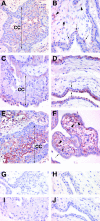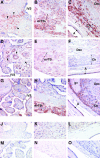The immunomodulatory proteins B7-DC, B7-H2, and B7-H3 are differentially expressed across gestation in the human placenta
- PMID: 16049332
- PMCID: PMC1603571
- DOI: 10.1016/S0002-9440(10)62990-2
The immunomodulatory proteins B7-DC, B7-H2, and B7-H3 are differentially expressed across gestation in the human placenta
Abstract
Placental trophoblast cells form a cellular barrier between the potentially immunogenic fetus and maternal leukocytes. Trophoblasts subvert maternal immunity by producing surface-bound and soluble factors that interact with maternal leukocytes. Here, we describe the distribution of three members of the expanding family of B7 immunomodulatory molecules: B7-DC, B7-H2, and B7-H3. B7-DC and B7-H3 inhibit antigen-stimulated lymphocyte activation while B7-H2 serves in a regulatory capacity, often promoting a Th2 immunophenotype. First trimester and term placentas, purified trophoblast cells, choriocarcinoma cell lines, and human umbilical vein endothelial cells were analyzed for B7 family RNA and protein expression. Transcripts and proteins for all three B7s were present throughout gestation but were differentially expressed within the trophoblast and the stroma. Whereas B7-DC was prominent on the syncytiotrophoblast of early placenta, it was absent from the trophoblast at term. In contrast, B7-H2 and B7-H3 were prominent on the extravillous trophoblast throughout gestation. Lastly, stromal cells, including macrophages and endothelial cells, differentially expressed B7-DC, B7-H2, and B7-H3, depending on gestational age. Thus, all three of these newly discovered B7 proteins are differentially positioned at the maternal-fetal interface such that they could steer maternal leukocytes away from a harmful immune response and toward a favorable one.
Figures





References
-
- Petroff MG, Hunt JS. Immunity at the maternal-fetal interface. Mestecky J, Bienenstock J, Lamm ME, Mayer L, McGhee JR, Strober W, editors. San Diego: Elsevier, Inc.,; Mucosal Immunology. 2005
-
- June CH, Bluestone JA, Nadler LM, Thompson CB. The B7 and CD28 receptor families. Immunol Today. 1994;15:321–331. - PubMed
-
- Greenfield EA, Nguyen KA, Kuchroo VK. CD28/B7 costimulation: a review. Crit Rev Immunol. 1998;18:389–418. - PubMed
-
- Petroff MG, Chen L, Phillips TA, Azzola D, Sedlmayr P, Hunt JS. B7 family molecules are favorably positioned at the human maternal-fetal interface. Biol Reprod. 2003;68:1496–1504. - PubMed
-
- Nishimura H, Minato N, Nakano T, Honjo T. Immunological studies on PD-1-deficient mice: implication of PD-1 as a negative regulator for B cell responses. Int Immunol. 1998;10:1563–1572. - PubMed
Publication types
MeSH terms
Substances
Grants and funding
LinkOut - more resources
Full Text Sources
Other Literature Sources
Molecular Biology Databases
Research Materials
Miscellaneous

